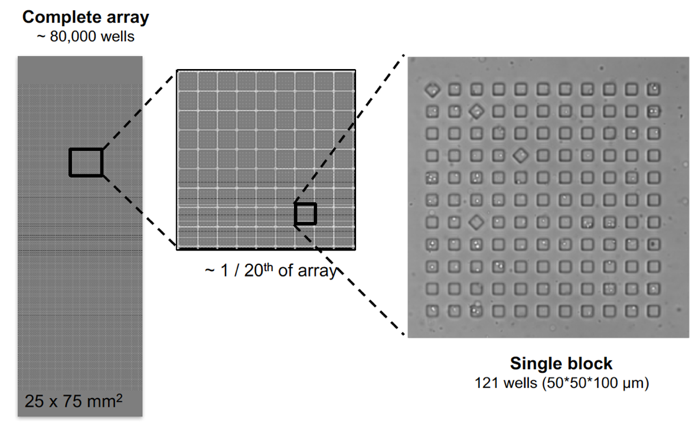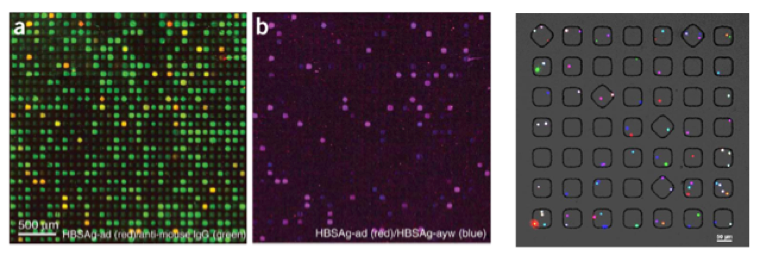What is a nanowell device?
An array of wells, manufactured from PDMS (a silicone-based organic polymer), using photolithography and replica molding. The device is comprised of blocks of subnanoliter wells within a 1” X 3” glass slide. Each array has roughly 85,000 wells, which can hold 1 to 5 cells each.Nanowell Arrays are manufactured by the Nanowell Cytometry Platform for use in single cell phenotyping and SeqWell single cell RNAseq.

Applications
Targeted Single Cell Phenotyping
A process which includes two complementary methods for characterization of individual cells within a population: 1) microengraving, to probe the secretory behavior of up to 100,000 individual cells and 2) multispectral fluorescent imaging to detect and analyze surface markers (up to 14) on cells in nanowell arrays. These methods enable identification of cells with specific expression patterns and provide information about cell type distribution within a population.

Left: Microengraving showing antibody microarray from a polyclonal marine hybridoma sample. Fig. a shows antigen and IgG specific positive cells. Fig. b shows cells double positive for two different antigens frome the same sample. Ogunniyi et al 2009
Right: A portion of the 11x11 grid showing different phenotypes of cells in wells of a nanowell device.
Review article on Microengraving
Profiling human antibody response
Monoclonal antibody discovery via hybridoma screening
Discovery of immunotherapy targets in tumor microenvironment
Functional analysis of Circulating Tumor Cells
Characterization of secreted factors in single human induced pluripotent stem cells
Different antibody repertoires in autoimmune disorders
Cell Recovery
Recovery of single cells from arrays by alignment of microengraving and/or imaging data sets with the array grid, identification and location of individual cells, and picking/transfer for culture and expansion or genome or expression analysis.

SeqWell
A relatively high throughput, cost-effective method for single cell RNAseq developed by Koch Institute investigators Chris Love and Alex Shalek. Individual cells are seeded into nanowell arrays and lysed, and the associated mRNA is attached to polyT containing beads. We work in collaboration with the Koch Institute Integrated Genomics & Bioinformatics Core/MIT BioMicro Center to support library preparation, quality control, sequencing and analysis.
For information on initial access, assisted service and training, please review our SeqWell Guidelines and these SeqWell Protocols.

